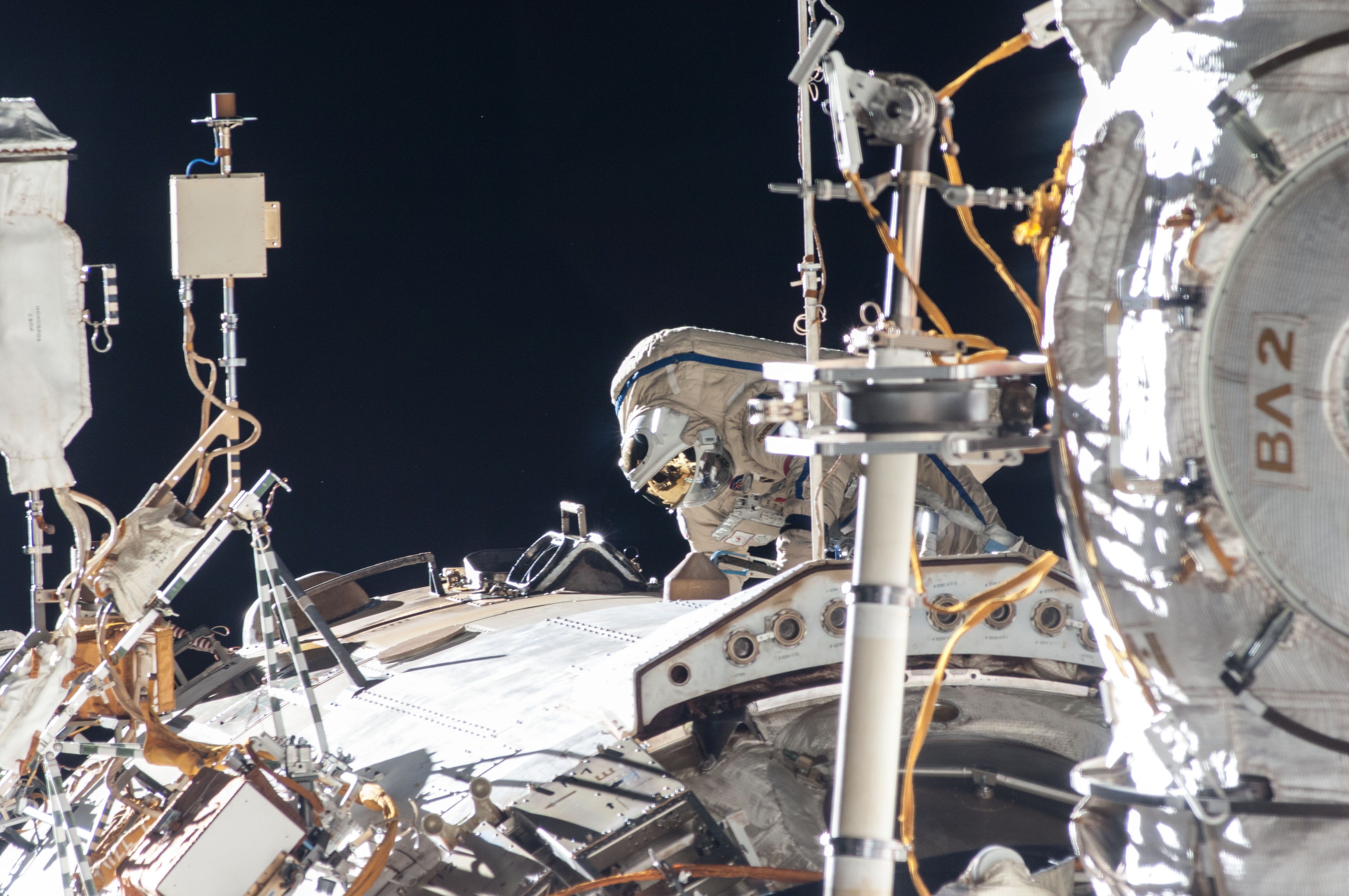
Before he launched from Earth on 28 March, Russian cosmonaut Pavel Vinogradov anticipated a hot and heavy summer of spacewalking. A total of four EVAs from the Russian segment of the International Space Station, and at least two from the U.S. segment, were planned between April and August. “It’s very hard to prepare a person to perform the EVA,” he said in a pre-flight NASA interview. “It’s very hard to measure and spread out the tasks between the crew members and the load between the crew members.” Since then, Vinogradov, who turns 60 on Saturday, 31 August, has established a new record as the oldest Russian ever to fly into space … and the oldest Russian ever to perform a spacewalk.
His historic EVA came on 19 April, three weeks after he and Soyuz TMA-08M crewmates Aleksandr Misurkin of Russia and NASA’s Chris Cassidy launched from Baikonur and docked at the multi-national orbital outpost in a mere six hours. For those first few weeks, his team formed a subset of Expedition 35—commanded by Canadian astronaut Chris Hadfield—and the 19 April EVA was performed by Vinogradov and Russian cosmonaut Roman Romanenko. The two men spent six hours and 38 minutes outside, deploying the Obstanovka plasma-wave and space-weather experiment and retrieving the Biorisk and one of two Vinoslivost materials sample panels. They also replaced a faulty navigational retroreflector to support the requirements of Europe’s Automated Transfer Vehicle (ATV)-4 “Albert Einstein” during its approach and docking in early June. The EVA was the seventh career spacewalk for Vinogradov and the first for Romanenko.
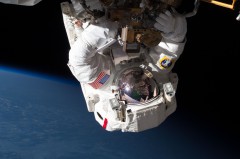
A few weeks later, shortly before the return of Expedition 35 crewmen Hadfield, Romanenko, and NASA’s Tom Marshburn to Earth, a serious incident arose aboard the station when a leak was visually observed in the form of ammonia “snow” emanating from the critical 2B power channel of the 17,000-pound P-6 truss. Within two days, a hasty contingency EVA plan was assembled, and on 11 May Cassidy and Marshburn ventured outside the station for five hours and 30 minutes. Although they found only a few tiny flakes of leaking ammonia, it was deemed prudent to remove, replace, and test a suspect Pump Flow Control Subassembly (PFCS), which was expected to yield additional clues for investigators as they sought the root cause of the problem.
Three days after the EVA, Hadfield, Romanenko, and Marshburn were safely back on Earth, having handed command of the space station to Vinogradov. This officially kicked off Expedition 36, whose inaugural three members were boosted to a full staff of six on 28 May, when Soyuz TMA-09M arrived with Russian cosmonaut Fyodor Yurchikhin, NASA’s Karen Nyberg, and Italian astronaut Luca Parmitano. It was already planned for Parmitano to participate in at least two EVAs from the U.S. segment with Cassidy—making him the first Italian ever to walk in space—but the sheer drama associated with the second of those spacewalks could hardly have been anticipated.
Ahead of the Cassidy-Parmitano EVAs was the first “official” spacewalk of Expedition 36, which took place on 24 June. It involved Yurchikhin and Misurkin and lasted six hours and 34 minutes. The two men—Yurchikhin making his sixth career EVA and Misurkin his first—worked to prepare the station for the arrival of Russia’s long-awaited “Nauka” (“Science”) Multi-Purpose Laboratory Module (MLM). Originally scheduled for launch in 2006, the module has been repeatedly delayed by organizational and other issues, most recently until December 2013, then April 2014, and probably will be postponed yet further. Yurchikhin and Misurkin retrieved a pair of science experiments, installed a new one, and replaced an aging fluid flow control panel on the Zarya module as preventative maintenance on the Russian segment’s cooling system. They also fitted clamps for future power cables as an early step toward removing the Pirs docking module and replacing it with Nauka.
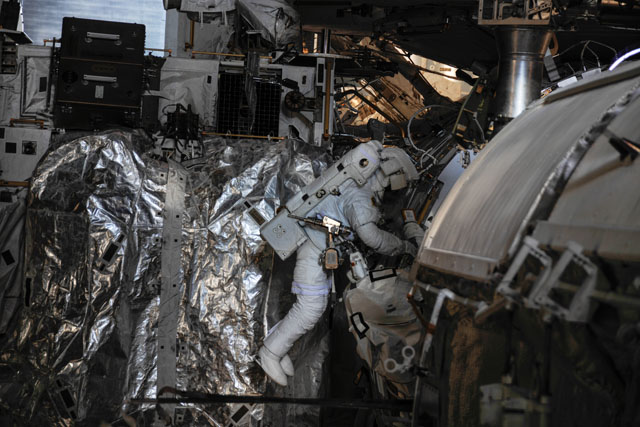
Two weeks later, on 9 July, history was made when an astronaut ventured into the void, clad in a pure white space suit … but with a notable exception: it bore the il Tricolore (tricolor) red, white, and green flag of Italy on its sleeve. Although preceded into orbit by several other Italians—including Italy’s first astronaut, Franco Malerba—it was the achievement of Luca Parmitano that he became the first of his countrymen in history ever to perform a spacewalk. Parmitano’s first EVA was a spectacular success. He and Cassidy—by now a veteran of four previous spacewalks, including the 11 May contingency—replaced a failed component of the Space-to-Ground Antenna (SGANT) hardware, which funnels data between the station and Mission Control through the Tracking and Data Relay Satellite (TDRS) network. Parmitano also retrieved two scientific experiments from the ExPRESS Logistics Carrier (ELC)-2 and the two men installed a pair of Radiator Grapple Bars (RGBs) to facilitate a means for the Canadarm2 robotic arm to interface with the station’s radiator elements, should the need ever arise to repair or replace them.
Cassidy also began a two-part task to install jumper cables to the Z-1 truss segment, which was to be completed during the dramatic second U.S. spacewalk on 16 July. Depressurization of the Quest airlock’s outermost “crew lock” was in work by 7:30 a.m. EDT, with a brief pause at 5 psi for standard leak checks, after which the pressure continued to drop down to near-vacuum. At 2 psi, the remaining oxygen in the crew lock was vented into space, and at 7:57 a.m. Cassidy and Parmitano switched their space suits’ life-support utilities onto internal battery power. This signaled the official start of the planned 6.5-hour EVA, a full 13 minutes ahead of schedule.
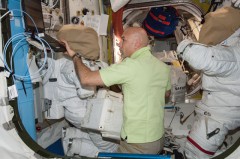
As planned, Parmitano departed the airlock first and began configuring tether and equipment, before Cassidy joined him and the two men checked themselves before splitting up on their separate first tasks. Cassidy returned to the Z-1 work site, atop the station’s Unity node. He quickly plunged into the task of concluding the reconfiguration of Y-Bypass jumper cables which started on EVA-22. Due to the sheer volume of cables, connectors, and jumpers—caused by numerous electrical and data system upgrades over the years—the area has been nicknamed “The Rat’s Nest.” By 8:35 a.m., he had completed the task and would have moved next to the P-1 and S-1 trusses to begin the installation of four radiator V-guides onto the two Radiator Grapple Bars (RGBs).
By this time, however, the first signs of trouble were already brewing. After he and Cassidy parted ways at the airlock, Parmitano translated “beneath” the Unity node toward its aft end cone, where he temporarily stowed a bag of data cables. He mated the 1553 data cables, hooking up the Power and Data Grapple Fixture (PDGF) on Russia’s Zarya module to ISS data systems on the Avionics Panel of the Tranquility node. This will ultimately permit the Canadarm2 robotic manipulator arm to access the Russian segment of the station. He then embarked on what should have been an hour-long task of retrieving and installing the Ethernet cable for Russia’s Nauka module, connecting one end to a space Ethernet connector at the junction between the Destiny, Unity, and Tranquility modules; he then began the process of laying out the cable as he worked his way aft toward the Russian Segment.
Then, at about 8:42 a.m. EDT, Parmitano made his reference to water inside his “Snoopy” communications cap. He was quickly joined by Cassidy, who verified that up to 800 milliliters of water was visible inside Parmitano’s helmet. Initially suspecting a coolant leak, he reduced the flow rate, and the possibility of a drinking bag leak seemed unlikely as it was already dry. Monitoring the increasingly tense situation from the Mission Control Center in Houston, Texas, was a team headed by ISS Flight Director David Korth. At 9:06 a.m., with Parmitano now reporting water in his eyes, Korth gave the call to terminate the EVA. Under his directive, Parmitano would proceed immediately to the airlock, whilst Cassidy stowed the Ethernet cable and cleaned up the work site.
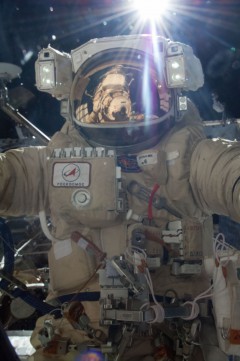
Within five minutes, Parmitano was back at Quest, by now with water droplets entering his eyes, nose, and mouth. Cassidy handled the closure of the hatch, which was locked at 9:26 a.m. and repressed back up to ambient ISS pressures 11 minutes later. “He looks miserable,” Cassidy said of his crewmate, “but he’s okay.” At 9:38 a.m., the hatch connecting the outer crew lock with the inner equipment lock was open and “intravehicular” crew member Karen Nyberg removed Parmitano’s helmet, releasing a flurry of water droplets in the process. The official “end time” for EVA-23 was 9:29 a.m. EDT, concluding a 92-minute spacewalk. This duration established the partially-successful spacewalk as the second-shortest ISS-based EVA in history. Investigative work to identify the cause of the problem is ongoing.
Since then, two more Russian EVAs have taken place, on 16 August and 22 August, both by Fyodor Yurchikhin and Aleksandr Misurkin. The first spacewalk created a new national record for the longest Russian EVA in history, as the cosmonauts spent no less than seven hours and 16 minutes outside the station. This eclipsed the previous Soviet/Russian record by 13 minutes, although it falls well shy of the all-time world EVA record of eight hours and 56 minutes, set by U.S. astronauts Jim Voss and Susan Helms in March 2001. During their epic spacewalk, Yurchikhin and Misurkin rigged Ethernet and other data cables onto Zarya in readiness for the arrival of the Nauka module. Misurkin also installed the Vinoslivost materials exposure experiment onto the Poisk module.
Most recently, on Thursday 22 August, Yurchikhin and Misurkin completed what is expected to be the final Expedition 36 EVA. They spent five hours and 58 minutes outside the space station, replacing a laser communications experiment with a new platform for a small optical camera system, together with new EVA aids and inspections of antenna covers. Near the end of their excursion, the cosmonauts unfurled a Russian tricolor flag in commemoration of Russian Flag Day.
Yesterday’s EVA marked the 173rd dedicated to ISS construction and maintenance since the initial STS-88 spacewalks in December 1998. It also marks the last scheduled EVA for Expedition 36, which will come to an end on 11 September when Vinogradov, Misurkin, and Cassidy board Soyuz TMA-08M and return to Earth. They will conclude a mission of 167 days and hand over the station to Yurchikhin, who will command Expedition 37 until mid-November. His crew will be joined on 25 September by Soyuz TMA-10M crewmen Oleg Kotov and Sergei Ryazansky of Russia, together with NASA astronaut Mike Hopkins.
Want to keep up-to-date with all things space? Be sure to “Like” AmericaSpace on Facebook and follow us on Twitter: @AmericaSpace



